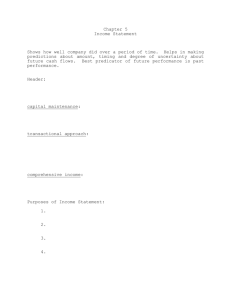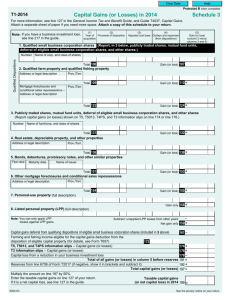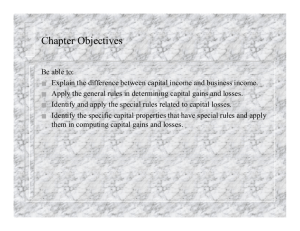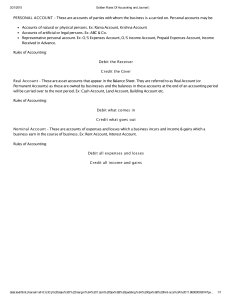Notes on Capital Gains Summary pages
advertisement
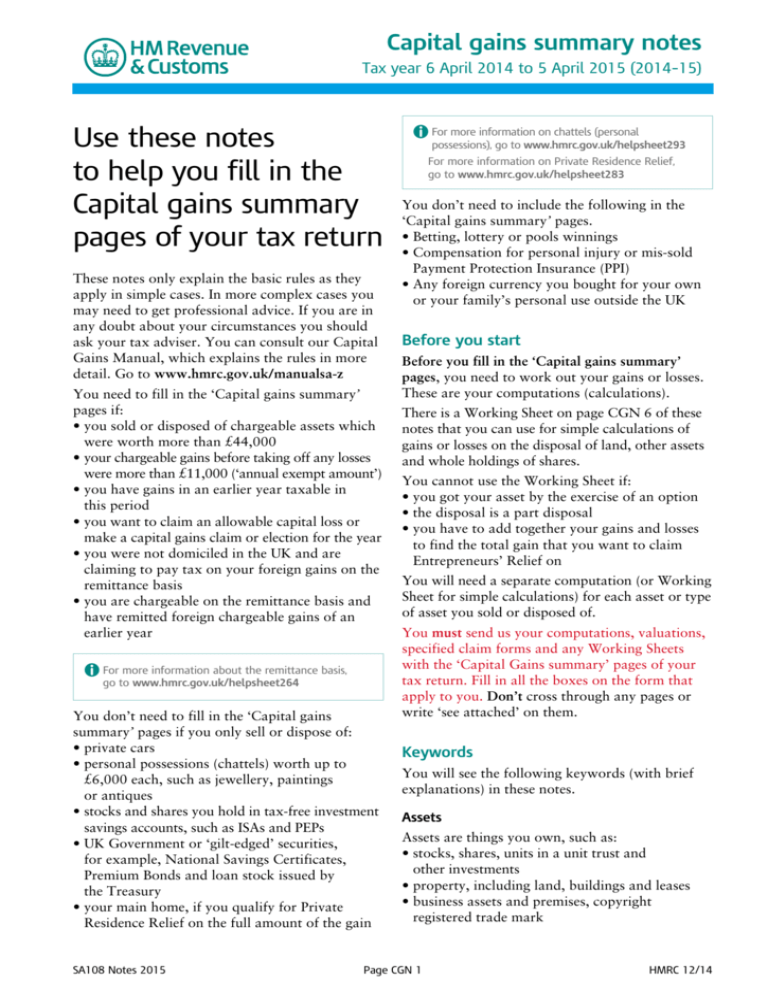
Capital gains summary notes Tax year 6 April 2014 to 5 April 2015 (2014–15) Use these notes to help you fill in the Capital gains summary pages of your tax return These notes only explain the basic rules as they apply in simple cases. In more complex cases you may need to get professional advice. If you are in any doubt about your circumstances you should ask your tax adviser. You can consult our Capital Gains Manual, which explains the rules in more detail. Go to www.hmrc.gov.uk/manualsa-z You need to fill in the ‘Capital gains summary’ pages if: •you sold or disposed of chargeable assets which were worth more than £44,000 •your chargeable gains before taking off any losses were more than £11,000 (‘annual exempt amount’) •you have gains in an earlier year taxable in this period •you want to claim an allowable capital loss or make a capital gains claim or election for the year •you were not domiciled in the UK and are claiming to pay tax on your foreign gains on the remittance basis •you are chargeable on the remittance basis and have remitted foreign chargeable gains of an earlier year AFor more information about the remittance basis, go to www.hmrc.gov.uk/helpsheet264 You don’t need to fill in the ‘Capital gains summary’ pages if you only sell or dispose of: •private cars •personal possessions (chattels) worth up to £6,000 each, such as jewellery, paintings or antiques •stocks and shares you hold in tax-free investment savings accounts, such as ISAs and PEPs •UK Government or ‘gilt-edged’ securities, for example, National Savings Certificates, Premium Bonds and loan stock issued by the Treasury •your main home, if you qualify for Private Residence Relief on the full amount of the gain SA108 Notes 2015 AFor more information on chattels (personal possessions), go to www.hmrc.gov.uk/helpsheet293 For more information on Private Residence Relief, go to www.hmrc.gov.uk/helpsheet283 You don’t need to include the following in the ‘Capital gains summary’ pages. •Betting, lottery or pools winnings •Compensation for personal injury or mis-sold Payment Protection Insurance (PPI) •Any foreign currency you bought for your own or your family’s personal use outside the UK Before you start Before you fill in the ‘Capital gains summary’ pages, you need to work out your gains or losses. These are your computations (calculations). There is a Working Sheet on page CGN 6 of these notes that you can use for simple calculations of gains or losses on the disposal of land, other assets and whole holdings of shares. You cannot use the Working Sheet if: •you got your asset by the exercise of an option •the disposal is a part disposal •you have to add together your gains and losses to find the total gain that you want to claim Entrepreneurs’ Relief on You will need a separate computation (or Working Sheet for simple calculations) for each asset or type of asset you sold or disposed of. You must send us your computations, valuations, specified claim forms and any Working Sheets with the ‘Capital Gains summary’ pages of your tax return. Fill in all the boxes on the form that apply to you. Don’t cross through any pages or write ‘see attached’ on them. Keywords You will see the following keywords (with brief explanations) in these notes. Assets Assets are things you own, such as: •stocks, shares, units in a unit trust and other investments •property, including land, buildings and leases •business assets and premises, copyright registered trade mark Page CGN 1 HMRC 12/14 •goodwill – that is the good name or reputation of the business •antiques and other personal possessions worth more than £6,000, such as ­— collectors’ items (for example, a chess set) — artwork — furniture or jewellery Disposals You usually dispose of an asset when you stop owning it. For example, if you: •sell it •give it away •transfer it •exchange it for something else This is a clogged loss. You must keep a separate record of each clogged loss you carry forward to later years. The term ‘connected people’ includes relatives, such as: •your husband, wife or civil partner •your and your partner’s brothers and sisters •your and your partner’s parents and grandparents and other ancestors •your and your partner’s children and other direct descendants •the partners of the relatives mentioned above It is also includes: •your business partners and their partners and relatives (except for genuine commercial acquisitions or disposals of partnership assets) •any company you control, on your own or with any releative mentioned above •the trustees of a settlement where you or any person connected with you is acting as a settlor For Capital Gains Tax purposes, a disposal includes a part-disposal. For example, you may have disposed of a part share in a house you inherited or you may have sold half of your collection of antique furniture. Sometimes you have disposed of all or part of an asset even though you still own it. For example, when you: •receive an insurance payout for a damaged asset •make a claim that an asset has become worthless (known as a negligible value claim) Special rules apply if you and your partner separate, divorce or dissolve your civil partnership. Sale or disposal proceeds Allowable costs Proceeds may include: •cash, payable now or in the future, or anything that can be turned into cash, unless it is taxable as income •the market value of an asset you were given in exchange for the asset you disposed of •the value of a right to receive future payments where you do not know the amount of the payment at the time you sold it For Capital Gains Tax purposes, you deduct your costs to work out the gain or loss on the sale or disposal of an asset. Only some costs are allowable. These include: •the price paid to buy the asset •the costs of any improvements made to your assets – but it must be reflected in the asset when you dispose of it •incidental costs of acquiring or disposing of the asset, such as Stamp Duty or Stamp Duty Land Tax Sometimes you need to use the market value of the asset instead of the sale or purchase price. AFor more information, go to www.hmrc.gov.uk/helpsheets/hs281.pdf Sometimes you use the market value of the asset instead of the actual cost – for example, if you received the asset as a gift. AFor more information about using the market value, go to www.gov.uk/capital-gains-tax/market-value Transferring assets between connected people If you sell, give or receive an asset from connected people you need to replace the price paid with the market value of the asset when you work out your gain or loss. If you make a loss you can only use that loss against gains you make on other disposals to the same connected person. Allowable losses You may make a loss when you sell or otherwise dispose of an asset that is liable to Capital Gains Tax. The loss will normally be an allowable loss, subject to your making a claim for it. Losses resulting from tax avoidance schemes may not be allowable losses. AFor more information, go to www.gov.uk/capital-gains-tax/losses Page CGN 2 General overview of capital gains and losses Summary of your enclosed computations The rules for working out capital gains and losses are sometimes complex and these notes don’t attempt to explain everything that could affect your capital gains computations. You may need helpsheets to help you fill in the ‘Capital gains summary’ pages. The details you put in boxes 18 to 36 will help you fill in the Summary section later. The notes to help you fill in the Summary section start on page CGN 5. You can find more details in the relevant section. AFor more information on capital gains, go to www.gov.uk/personal-tax/capital-gains-tax Listed shares and securities How to make a capital gains tax claim, election or give notice You can use your ‘Capital gains summary’ pages to: •claim a relief against a Capital Gains Tax •make an election (except for foreign losses if you are claiming the remittance basis) •give notice, for example to tell us that you have made a Capital Gain Loss in the tax year To make your claim, election or give notice, use the table below. Put the appropriate 3-letter code in box 22, 28 or 35 (whichever applies). You will also need to give full details about your claim, election or notice in box 37, ‘Any other information’. Claim, election or notice Before you fill in the Summary section (boxes 3 to 17), you need to complete the right sections for you. This could be: •listed shares and securities (boxes 18 to 23) •unlisted shares and securities (boxes 24 to 29) •property and other assets and gains (boxes 30 to 36) •a combination of the sections Code Private Residence Relief where Lettings Relief does not apply PRR Private Residence Relief where Lettings Relief applies LET These are: •shares or securities from a company listed on a recognised stock exchange •shares in a UK open-ended investment company •units in an authorised unit trust If you have any unlisted shares and securities fill in boxes 24 to 29. Box 18 Number of disposals Put the number of disposals of any listed shares and securities that you made from 6 April 2014 to 5 April 2015 in box 18. Count all disposals of the same class of share or security in the same company made on the same day as a single disposal. Ignore disposals you do not make in your own capacity, for example, disposals you make as a trustee. AFor more information about shares and Capital Gains Gift Hold-Over Relief GHO Rollover Relief ROR Employee Shares ESH Entrepreneurs’ Relief ERL Box 19 Disposal proceeds Negligible Value Claims NVC Put the total disposal proceeds for all your listed shares and securities (before taking off any reliefs, claims or elections) in box 19. Social Investment Tax Relief SIR Other claims OTH If more than 1 code applies MUL Tax, go to www.hmrc.gov.uk/helpsheet284 Box 21 Gains in the year, before losses Put the total of any gains you made on listed shares and securities in box 21. This figure will Put your full name and Unique Taxpayer be the gain minus any relief, claims or elections. Reference (UTR) in the boxes at the top of the ‘Capital gains summary’ pages. You will find your Only deduct losses if you included them in a claim for Entrepreneurs’ Relief. Capital gains summary UTR on any letters from us. Boxes 1 and 2 Tax year 6 April 2014 to 5 April 2015 (2014–15) 1 Your name 2 Your Unique Taxpayer Reference (UTR) AFor more information about Entrepreneurs’ Relief, Summary of your enclosed computations Example ‘Capital gains summary’ pagein this section. You must enclose your computations, Please read theof ‘Capital gains summary notes’ before filling including details of each gain or loss, as well as filling in the boxes. 3 Page CGN 3 To get notes and helpsheets that will help you fill in this form, go to www.hmrc.gov.uk/selfassessmentforms Total gains (boxes 21 + 27 + 33 + 34) 11 Losses used against an earlier year’s gain go to www.hmrc.gov.uk/helpsheet275 Box 22 If you are making any claim or election, put the relevant code in the box Box 28 If you are making any claim or election, put the relevant code in the box If you make a claim or election, you must tell us in your computation. Your can find your 3-letter code in the table on page CGN 3. If you make a claim or election, you must tell us in your computation. You can find your 3-letter code in the table on page CGN 3. Box 23 If your computations include any estimates or valuations, put ‘X’ in the box Box 29 If your computations include any estimates or valuations, put ‘X’ in the box If your computation includes estimated figures, or a valuation, you must tell us: •where and why you have used estimated amounts •how you worked out these amounts If your computation includes estimated figures or a valuation, you must tell us where and why: •you have used estimated amounts •how you worked out these amounts For valuations, you should also include: •the date of the valuation •full description of the asset For valuations, you should also include: •the date of the valuation •full description of the asset Property and other assets and gains Unlisted shares and securities These are any shares and securities not included in the listed shares definition. For example, shareholdings in Alternative Investment Market companies are ‘unlisted’. Box 24 Number of disposals Put the number of disposals of any unlisted shares and securities that you made from 6 April 2014 to 5 April 2015 in box 24. Box 30 Number of disposals Put the number of disposals of property and other assets that you made from 6 April 2014 to 5 April 2015 in box 30. If you have claimed Entrepreneurs’ Relief, and have aggregated losses and gains to arrive at the chargeable gain, count each disposal separately. Box 31 Disposal proceeds Count all dispoals of the same class of share or security in the same company made on the same day as a single disposal. Put the total disposal proceeds for all property and other assets and gains (before taking into account any reliefs or claims) in box 31. Ignore disposals you do not make in your own capacity, for example, disposals you make as a trustee. Box 32 Allowable costs (including purchase price) Put your total allowable costs in box 32. Box 25 Disposal proceeds Box 33 Gains in the year, before losses Put the total disposal proceeds for all your unlisted shares and securities (before taking off any reliefs, claims or elections) in box 25. Put the total of any gains made on the disposal of property and other assets in box 33. This figure will be the gain minus any relief, claims or elections. Box 26 Allowable costs (including purchase price) Put your total allowable costs in box 26. Box 27 Gains in the year, before losses Put the total of any gains you made on unlisted shares and securities in box 27. This figure will be the gain minus any relief, claims or elections. Only deduct losses if you included them in a claim for Entrepreneurs’ Relief. AFor more information about Entrepreneurs’ Relief, go to www.hmrc.gov.uk/helpsheet275 You also need to put some gains from earlier years in box 33. For example, if: •you claimed Rollover Relief on the purchase of a wasting asset •you claimed Gift Hold-Over Relief on a transfer of an asset to you and you are now non-resident •a gain on qualifying corporate bonds was deferred due to a share reorganisation •you deferred a gain on a subscription for Enterprise Investment Scheme or Venture Capital Trust shares •a gain accrued when you were temporarily not resident in the UK Page CGN 4 •a previously unremittable gain was remitted in the year •a foreign chargeable gain from an earlier year was remitted to the UK in 2014–15 Only deduct losses if you included them in a claim for Entrepreneurs’ Relief. Do not deduct the ‘annual exempt amount’, you will get this automatically. AFor more information about Entrepreneurs’ Relief, go to www.hmrc.gov.uk/helpsheet275 Box 34 Attributed gains where personal losses cannot be set off Only fill in this box if you have received any gains, capital payments or benefits, as a beneficiary from a non-UK resident trust. AFor more information, go to www.hmrc.gov.uk/helpsheet301 Box 35 If you are making any claim or election, put the relevant code in the box If you make a claim or election, you must tell us in your computation. You can find your 3-letter code in the table on page CGN 3. Box 36 If your computations include any estimates or valuations, put ‘X’ in the box If you put an ‘X’ in box 36, you must tell us, in box 37, which figures you estimated and why you have used estimated amounts. If your computation includes a valuation for land or buildings, give a description of the property (attach a copy of the plan if it helps) and tell us if: •the property was freehold or leasehold •you let (rented out) the property during your ownership •you have already asked us to check your valuation, by sending us a form CG34, ‘Post-transaction valuation checks for capital gains’ Any other information Box 37 Please put any additional information in this box. For example: •if you are making a claim or an election for losses on foreign assets to be allowable losses, write in the box ‘I elect for my foreign losses to be allowable losses’ •any gains out of your computations, such as foreign gains that you are unable to bring into the UK •any estimated figures •anything you would like to add to support your computations Summary of your enclosed computations Box 3 Total gains If you have made a gain from selling or disposing of your assets, then use the figures you put in boxes 21, 27, 33 and 34, and put the total in box 3. Do not deduct the ‘annual exempt amount’, you will get this automatically. Box 4 Gains qualifying for Entrepreneurs’ Relief (but excluding gains deferred from before 23 June 2010) Put in box 4, the total amount of all your gains made on or after 6 April 2014 (and in the period 23 June 2010 to 5 April 2011 that were deferred gains) that qualify for Entrepreneurs’ Relief. AFor more information, go to www.hmrc.gov.uk/helpsheet275 Box 5 Gains invested under Seed Enterprise Investment Scheme and qualifying for relief Put in box 5 the total of all your gains made on the disposal of assets in the year to 5 April 2015 where, because of reinvestment into shares issued to you, or treated as issued to you, in that year by 1 or more Seed Enterprise Investment Companies, you claim that they qualify for exemption. You need to use and attach the claim forms, provided with the SEIS3 certificates, to the ‘Capital gains summary’ pages of your tax return. AFor more information, go to www.hmrc.gov.uk/helpsheet393 Page CGN 5 Computation Working Sheet (for straightforward calculations) – complete 1 sheet for each asset sold Description of asset, for example, type and number of shares sold or address of property Date of disposal/sale DD MM YYYY Disposal/sale proceeds or market value if appropriate A £ Incidental costs of disposal/sale B £ C £ Net disposal proceeds box A minus box B Date of acquisition DD MM YYYY Cost or 31 March 1982 value see page CGN 2 D £ Incidental costs of acquisition E £ Improvement costs F £ Total costs boxes D + E + F G £ Gain or loss box C minus box G H £ I £ Capital gains elections or reliefs, not the annual exempt amount, and description J £ Net gain box H minus box I Page CGN 6 £ 6 • If you have any losses, claim them here, incude the details of your losses in your computations. The time limit for claiming losses is 4 years from the tax year in which you made the loss. If you can’t use all your losses for this year, you can either: •carry them forward to use against future gains – put the amount in box 10 •carry them back (in certain circumstances) to use against previous years’ gains – put the amount in box 11 Box 6 Total losses of the year Put in box 6 the total amount of all your losses for this tax year only. Include any ‘clogged losses’ and losses that you intend to put in box 16. If you had no losses, you must put ‘0’ in the box. If you make a loss on an asset from a connected person, you can only use that loss against gains you make on other disposals to the same person. This is a ‘clogged loss’. You must keep a separate record of each clogged loss you carry forward to a later year, and tell us which losses are clogged and why in your computations. Don’t include any losses on individual assets that you used in a claim for Entrepreneurs’ Relief. Box 7 Losses brought forward and used in the year You can only use losses brought forward to reduce gains to the ‘annual exempt amount’ for the year. For the tax year 2014–15 the annual exempt amount is: •£11,000 for individuals •£5,500 for most trustees Tell us about your losses within 4 years of the end of the tax year you made the loss in. The latest date to claim 2013–14 losses is 5 April 2018. Box 8 Adjustment to Capital Gains Tax If the adjustment reduces the amount of Capital Gains Tax payable, put a minus sign in the shaded box in front of your figure. You need to put a net adjustment in box 8 if: •your capital gain has Foreign Tax Credit Relief •your capital gain includes a liability for non-resident or dual resident trusts •you have claimed the remittance basis in an earlier tax year and made an election for foreign losses •you have clogged losses •you are chargeable to Income Tax on disguised interest and wish to avoid double taxation You must tell us in your computations what the adjustment relates to and how you worked it out. £ Total losses of the year – enter ‘0’ if there are none £ Losses Enter Inves 0 0 • 0 0 14 If the adjustment reduces the amount of Capital 7 Losses brought forward and used in the year Gains Tax payable, put a minus sign in the shaded • 0 0 box in£front of your figure. £ 15 8 Adjustment to Capital Gains Tax – read the notes £ • 0 0 liability for non-resident or dual resident trusts 9 Additional Example of Capital gains summary page £ • 0 0 Amou Enter Inves £ 16 Incom £ Box 9 Additional liability for non-resident or dual resident trusts available to be carried forward to later years 10 Losses You will • 0 0 £ need Helpsheet 301, ‘Beneficiaries receiving capital payments from non-resident trusts: calculation of the increase in tax charge’ to work out the amount to put in box 9. Losse again 17 Defer for En £ AFor more information, go to www.hmrc.gov.uk/helpsheet301 Box 10 Losses available to be carried forward to later years You can carry your unused losses (including ‘clogged losses’) forward to later years. You must keep separate records of any unused losses claimed SA108 2014 Page for 1995–96 and earlier years, and 1996–97 and CG 1 later years. Box 11 Losses used against an earlier year’s gain This box only applies in limited circumstances. For example, when someone dies. AFor more information, go to www.hmrc.gov.uk/helpsheets/hs282.pdf T o find out about carrying back losses to earlier years, go to www.hmrc.gov.uk/manualsa-z Box 12 Share Loss Relief used against income – amount claimed against 2014–15 income This box only applies if you can set capital losses against your 2014–15 income. You will need Helpsheet 286, ‘Negligible value claims and Income Tax losses on disposals of shares you have subscribed for in qualifying trading companies’, Helpsheet 297, ‘Enterprise Investment Scheme and Capital Gains Tax’ and Helpsheet 393, ‘Seed Enterprise Investment Scheme – Income Tax and Capital Gains Tax Relief’ to help you fill in this box. AFor more information, go to Page CGN 7 www.hmrc.gov.uk/helpsheet286 www.hmrc.gov.uk/helpsheet297 and www.hmrc.gov.uk/helpsheet393 Box 13 Amount in box 12 relating to Share Loss Relief to which Enterprise Investment Scheme/ Seed Enterprise Investment Scheme Relief is attributable Put the amount you included in box 12 for shares that Enterprise Investment Scheme or Seed Enterprise Investment Scheme Relief is due. Box 14 Losses used against income – amount claimed against 2013–14 income This box only applies if you can set capital losses against your 2013–14 income. You will need Helpsheet 286, ‘Negligible value claims and Income Tax losses on disposals of shares you have subscribed for in qualifying trading companies’, Helpsheet 297, ‘Enterprise Investment Scheme and Capital Gains Tax’ and Helpsheet 393, ‘Seed Enterprise Investment Scheme – Income Tax and Capital Gains Tax Relief’ to work out if you can fill in these boxes. AFor more information, go to Box 17 Deferred gains from before 23 June 2010 qualifying for Entrepreneurs’ Relief If you deferred gains on disposals made before 23 June 2010 for which you claimed Entrepreneurs’ Relief, use Helpsheet 275, ‘Entrepreneurs’ Relief’ to help you. Working Sheet Use the Working Sheet is for straightforward calculations of gains or losses. You can use it for: •the disposal of land or other assets •the disposal of shares – as long as it is the whole of your holding of a class of shares You cannot use the Working Sheet if: •you got your asset by the exercise of an option •the disposal is a ‘part disposal’ •you have to add together your gains and losses on the sale of any assets to find the total gain that you want to claim Entrepreneurs’ Relief on More help if you need it www.hmrc.gov.uk/helpsheet286, www.hmrc.gov.uk/helpsheet297 and www.hmrc.gov.uk/helpsheet393 You can find helpsheets to help you to fill in the ‘capital gains summary’ pages at www.gov.uk/government/collections/ self-assessment-helpsheets-capital-gains Box 15 Amount in box 14 relating to shares to which Enterprise Investment Scheme/ Seed Enterprise Investment Scheme Relief is attributable Put the amount you included in box 14 for shares that Enterprise Investment Scheme or Seed Enterprise Investment Scheme Relief is due. Box 16 Income losses of 2014–15 set against gains Put the amount of any allowable trading losses that you want to set against chargeable gains in box 16. This should be the lower of: •the total losses you can claim •the amount required (after setting off capital losses for the year) to reduce the gain to zero If you are unable to go online: •phone the Self Assessment Orderline on 0300 200 3610 for paper copies of the helpsheets and forms • phone the Self Assessment Helpline on 0300 200 3310 for help with your tax return We have a range of services for disabled people. These include guidance in Braille, audio and large print. Most of our forms are also available in large print. Please contact our helplines for more information. AFor more information, go to www.hmrc.gov.uk/helpsheet227 These notes are for guidance only and reflect the position at the time of writing. They do not affect the right of appeal. Page CGN 8
